Can Bed Bugs Live In Your Hair?
The short answer: NO.
Bed bugs will not live on your skin or hair.
For one bed bugs, take harborage near their host and not on them.
Unlike ticks and lice, bed bugs only attach themselves to you when they are sucking your blood.
Once they’re done feeding, they will go back to their harborage until they’re ready to feed again.
Also, bed bugs generally avoid hair.
While lice and ticks are equipped with claws designed to climb through hair, bed bugs aren’t. As such, they would generally avoid hair when they crawl on you.
What Are Bed Bugs?
Bed bugs are insects that feed on blood.
While they prefer to drink on human blood, they would drink alternative blood from animal hosts such as cats, dogs, rats, and birds.
They feed on their host by grabbing on to their skin using their front legs and rocking back and forth to penetrate it.
Once their mouthparts are injected, Bed bugs extract blood from their host until they are satisfied.
Bed bugs do not live on their hosts. Instead, they come out of their harbor area to feed.
Once done, they come back to safety until they are ready to feed again.
Feeding typically happens at night as the host is sleeping. But, bed bugs can alter their feeding habits according to the availability of their host.
Bed Bug vs. Tick vs. Head Lice
Bed bugs are unlikely to live in your hair. If you find bugs in your hair, it’s likely that what you have is either tick or lice.
Bed Bug vs. Tick vs. Head Lice: Appearance
Bed Bugs Appearance:
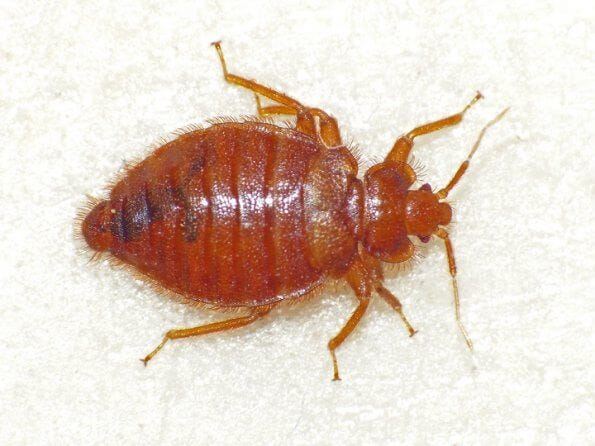
Bed bugs are around 1/8 inches long and 1/4 inches wide. Their eggs are small at .04 inches.
Adult bed bugs are brown to reddish-brown and look similar to ticks when unfed.
They have an oval shape and flattened from top to bottom.
Bed bugs have pyramidal and pronounced eyes. They also have two thin antennae.
While adult bed bugs develop wing pads, they do not fly. Bed bugs do not grow functional wings.
Tick Appearance:
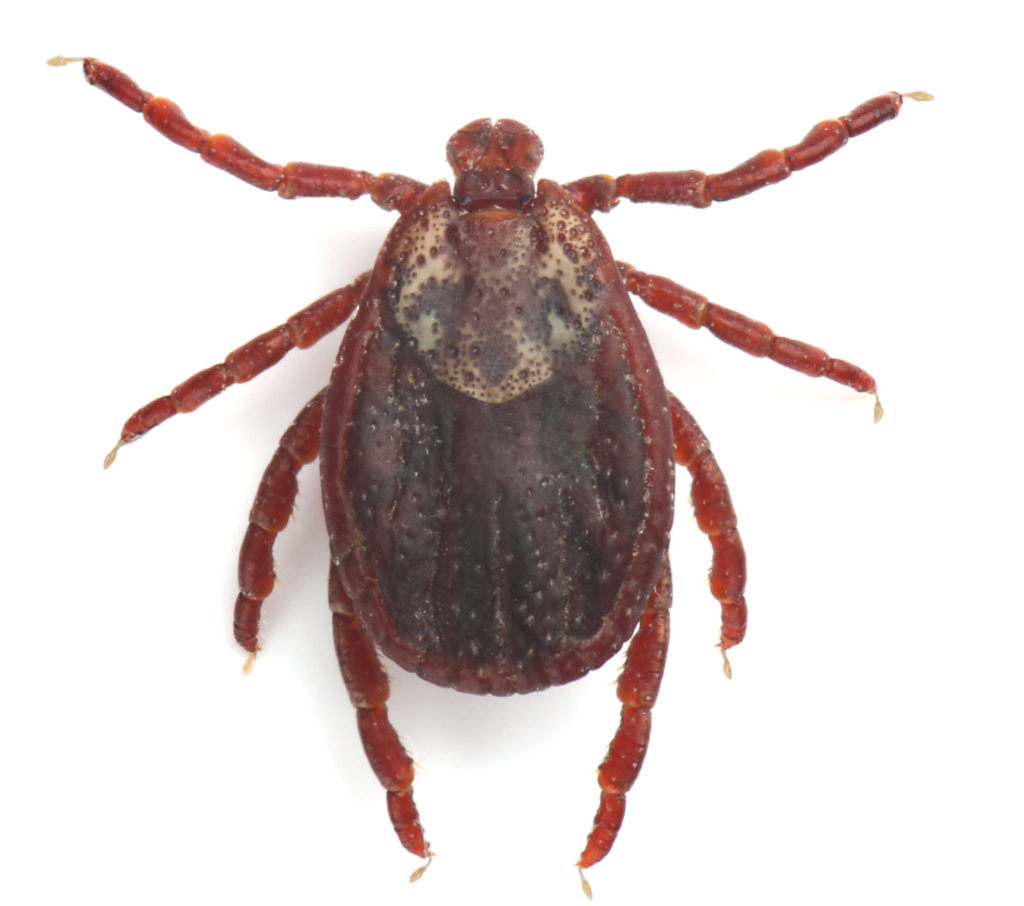
Adult ticks can range in size from 5mm to 15mm. They are much larger when engorged, reaching sizes of 15mm.
Like bed bugs, ticks have an oval-shaped body.
Depending on the tick species, their color can vary from light brown to dark red or black. When engorged, ticks become darker and take on a reddish black color.
Ticks have eight legs with four forward-facing and four facing backward. They do not have antennas.
Both bed bugs and ticks do not have wings and cannot fly.
Head Lice Appearance:
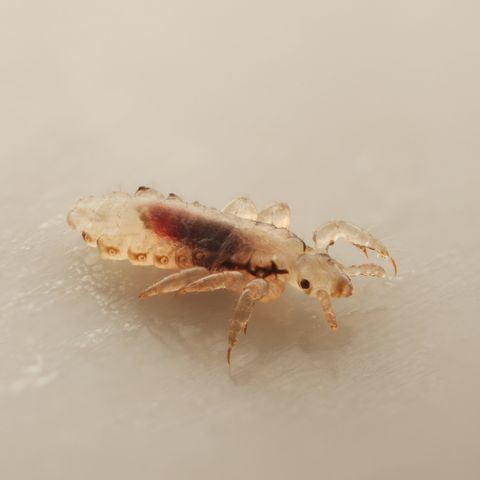
Head lice are about 3mm in length. They are grayish or tan in color.
Head lice eggs have round or oval shapes and appear yellow or white.
They are firmly attached to the hair shaft.
Bed Bug vs. Tick vs. Head Lice: Bites
Bed Bug Bites
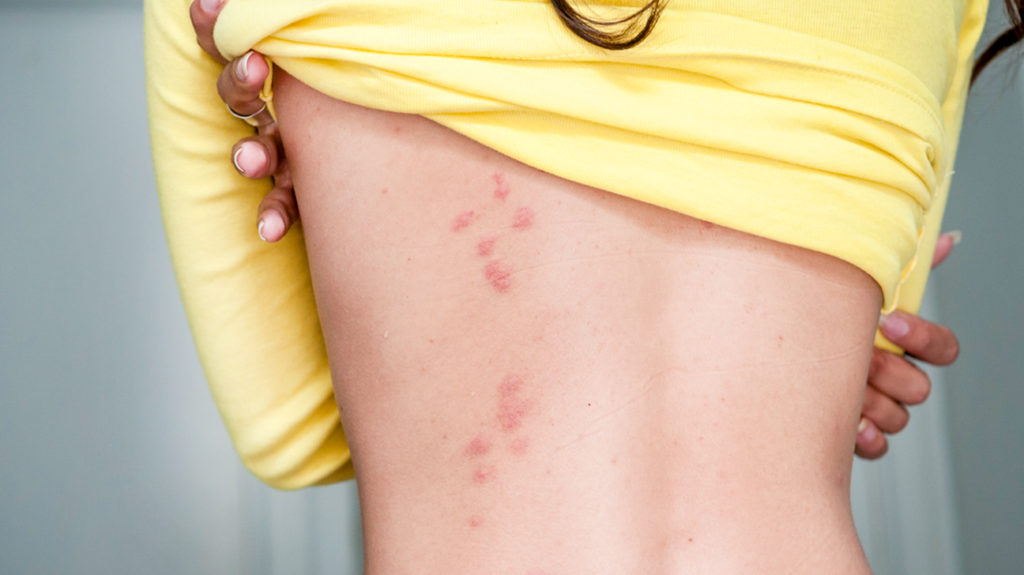
Bed bugs are more likely to target your legs, back, and torso. They will rarely bite on neck and face unless you’re wearing pants and long sleeves.
Their bites look like welts and do not have a red spot at the center, unlike other insect bites such as spiders and fleas.
Bed bugs will bite you anywhere there is exposed skin.
Common locations for bed bites include:
- Arms
- Legs
- Ankles
- Back
- Torso
- Neck
- Feet
Tick Bites
Unlike bed bugs, ticks stay attached to their host for several days before they release their grip.
Tick bites typically leave red welts on the skin with some residual redness around the bite mark.
Lice Bite
Lice live in the head and feed in that area.
They especially like to feed on warmer areas, such as the back of the head and behind the ears.
Lice bites look like small reddish or pink bumps. They are itchy and can be infected When scratched excessively.
How Do Bed Bugs Get in Hair?
Bed bugs are non-discriminating and expert stowaways.
If you find one in your hair, you’ve likely traveled to a place with an infestation.
While bed bugs won’t live in your hair, they may get in your hair if you’ve stayed in a bed-bug infested area.
And if you get one while traveling, the bug can repopulate and infest your home.
It’s also possible that you’ve got a bed bug on your hair if you’re dealing with an infestation at home.
If bed bugs are harboring in your mattress or couch, they may crawl on your hair while you’re asleep.
That said, bed bugs generally avoid hair and would prefer to feed on exposed skin.
As such, if you do find a tiny bug on your hair, make sure it’s bed bugs and not other insects before doing any treatment.
Will Bed Bugs Lay Eggs in Your Hair?
No. Bed bugs do not live or lay their eggs on their host.
But they will live very close to where you stay the longest. That’s typically your mattress and couch.
When they are hungry, they will leave their nest to feed on you.
They will locate you by sensing heat, scent, and the CO2 from your breath.
Once bed bugs find you, they will feed on your blood until they are satisfied.
The most likely place to find bed bug eggs is cracks, crevices, and fabric seams on your furniture.
These bugs will generally avoid harborage areas that are exposed to air movements.
If you find bug eggs in your hair, it’s more likely that you have lice than bed bugs.
Bed Bug Eggs vs. Head Lice Eggs:
Bed Bugs
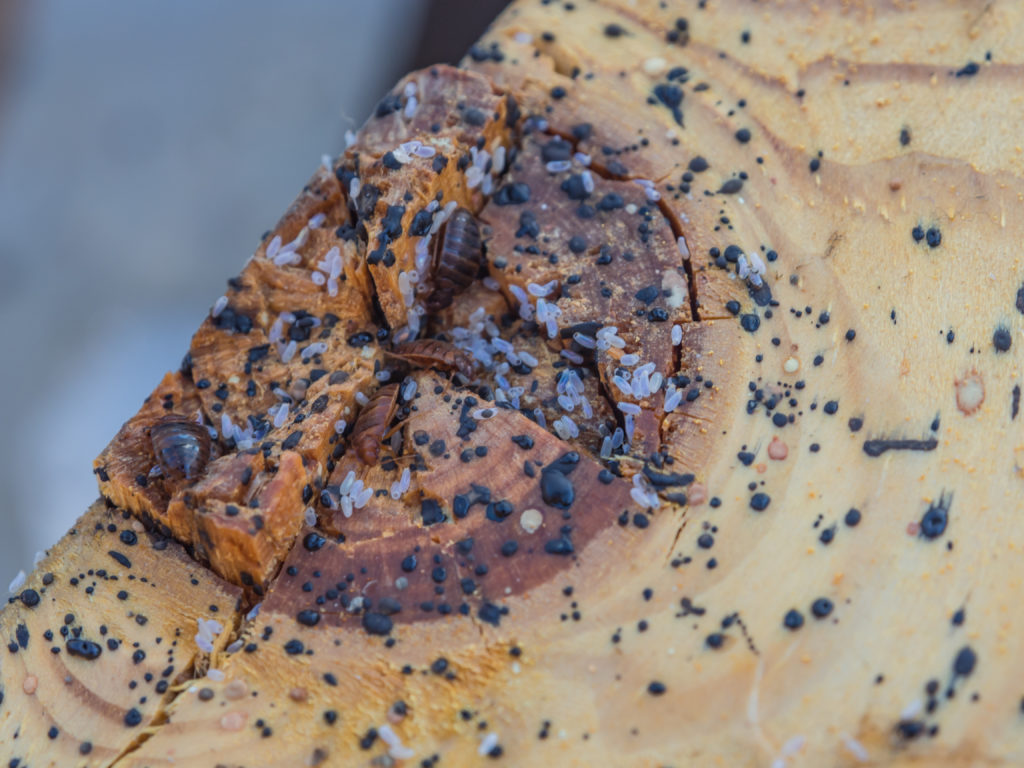
Bed bugs eggs are white and small at .04 inches. You’ll typically find them in cracks, crevices, and fabric seams on bedroom furniture.
Lice
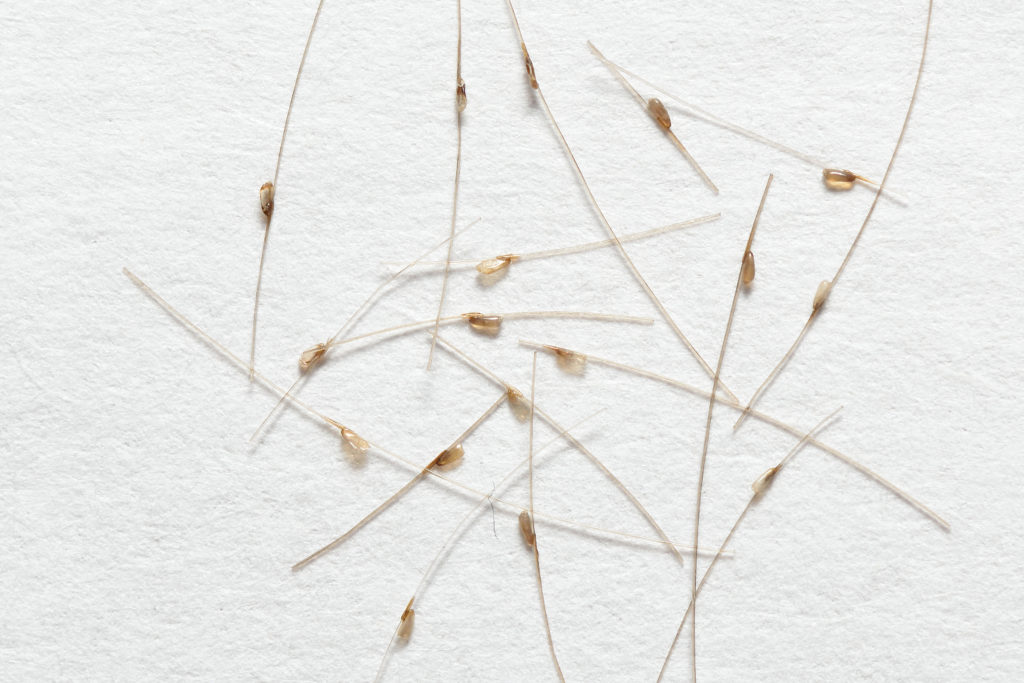
Head lice eggs have round or oval shapes and appear yellow or white. They are firmly attached to the hair shaft.
Symptoms of bedbugs on living on your head
Bed bugs do not live on their hosts.
If you are certain that a bug is living on your hair, it’s likely a head lice or a tick.
Here are some symptoms of bites from each insect:
Bed Bug Symptoms:
Bed Bug Symptoms: Bedbug bites look like welts. They can appear anywhere between an hour and two weeks after the bite occurs. These bites are itchy and uncomfortable.
Pattern: Bed bugs come in clusters and occur in a line or a zig-zag pattern.
Location: Bed bugs are more likely to target your legs, back, and torso. They will rarely bite on the neck and face unless you’re wearing pants and long sleeves.
Development: While rare, bed bug bites can develop into severe reactions such as blisters, difficulty breathing, and nausea. Severe reactions to mosquito bites can cause significant swelling, hives, and fever.
Tick Symptoms:
Tick Symptoms: Ticks bites are usually painless and don’t itch at all.
These bites typically leave red welts on the skin with some residual redness around the bite mark. You may also find a tick still attached to the surface to feed.
Pattern: Ticks produce a bulls-eye rash pattern. That is, you’ll see a red are and another ring around the bite mark.
Location: Ticks typically bite on the neck, scalp, groin, and legs.
Development: Tick bites can develop into irritation, fever, and tick-borne diseases.
Head Lice Symptoms:
Head Lice Symptoms: Head lice can lead to tiny red bumps that develop into extreme itching on the scalp.
Location: Scalp, over the ear, and nape of the neck.
Development: Head lice can develop into tiny red bumps that can get infected with bacteria.
How to Get Rid of Bed Bugs in Hair?
Bed bugs do not live on their host.
If you find a bed bug in your hair, the first thing you should do is verify that it’s a bed bug.
You can do this by brushing a lice comb on your hair and placing the bugs in a container.
Once you have the bug, study it, or ask a professional to determine whether it’s a bed bug.
- Wash Your Hair
There are a few different ways you can eliminate bed bugs on your hair. The easiest way to do this is to wash your hair with products that will bed bugs.
These include:
- Neem Oil
- 91% Rubbing Alcohol
- Head Lice Shampoo
These products will kill bed bugs on contact making getting rid of your bed bugs fast.
For the best results leave the product in your hair for at least 15-20 minutes.
Also make sure to apply to all the hair on your body. This will increase the chances of the product coming into direct contact with the bed bugs.
- Use Hot Water
When washing and rinsing your hair always make sure to use hot water. Using higher temperature significantly increases that chance the bd bug will die.
- Use a Comb
Finally use a fine tooth comb to remove any remaining dead or live bed bugs from your head.
- Repeat
If you feel bed bugs are still in your head repeat steps
FAQ
Do Bed Bugs Drown?
Yes. Bed bugs can drown, but the exact amount of time it takes for them to drown is inconclusive.
The truth is that bed bugs can not swim. Once bed bugs are inside water, it is very difficult for them to try and get out.
Their short legs don’t allow them to swim or propel themselves forward.
While there are reports that bed bugs will drown within 24 hours or even 8 hours, the reality is that there is no conclusive evidence to prove this.
A report subjecting bed bugs to low levels of oxygen, only 36% died after 8 hours. The study did prove that the mortality rate increases drastically as temperatures increase.
Increasing the temperature by 10 degrees (from 77 to 80 degrees) increases the mortality rate by 60%.
Suggesting bed bugs are more susceptible to extreme temperatures rather than oxygen deprivation.
Another issue with trying to drown bed bugs is that they can float. If the bed bugs are not fully submerged underwater, they can survive for at least several days.
There is also no conclusive evidence to suggest how long bed bugs could survive floating on water.
Can hair dryers kill bed bugs?
Yes. Temperatures beyond 120 Fahrenheit can kill bed bugs.
So any hair dryers that can go beyond that can undoubtedly kill bed bugs.
To kill bed bugs with a hairdryer, you’ll need to set it at least 120 degrees and expose the bugs to them for 90 minutes.
Another way you can use a hairdryer to kill bed bugs is to lure them out of their hiding spots.
Researchers found that bed bug activity increases at temperatures higher than 80 degrees.
That’s because bed bugs use heat to locate their host and get their blood meal.
Temperatures produced by hairdryers are perfect for attracting bed bugs.
Using the blow dryer on the medium and low setting is hot enough to draw bed bugs towards the blow dryer.
Once they are out, you can expose them to chemical insecticides to kill them. You can also use a bed bug trap to trap them.
Can bed bugs cause hair loss?
No. Bed bugs do not cause hair loss.
The only way bed bugs can impact hair loss is with the stress of dealing with them.
Bed bugs are one of the most difficult pests to treat. As such, it’s not uncommon for them to cause property owners plenty of stress.
Significant stress can push hair follicles into a resting phase. If the follicles stay in this phase for an extended period, they might fall out.
Can bed bugs get in your private parts or pubic hair?
They generally avoid biting unexposed skin, including skin that’s covered with clothing or hair.
That’s because unlike ticks or lice, bed bugs are not physically equipped to crawl through hair.
As such, they tend to target skin that’s free of clothing or hair.
So, unless your private parts are exposed, it’s unlikely that bed bugs will crawl and feed on that area.
How To Get Rid Of Bed Bugs?
Identification
The first step to treating bed bugs is to identify if you have an infestation and where.
Signs Of Bed Bug Infestation:
- Live Bed bugs – Bed bugs are about the size of a grain of rice, oval, flat, and light brown to reddish-brown.
- Bed Bug Eggs – Bed bugs are smaller than a grain of rice, white and are oval.
- Dried Blood – Small specs of fresh blood will look like dark red dots around your couch.
- Skin Casings – Bed bugs shed their skin to grow. The presence of these skin cases is a good sign of bed bug infestation.
- Bed Bug Bites – Bed bug bites look like welts and do not have a red spot at the center, unlike other insect bites such as spiders and fleas.
Ideal areas to look for signs of bed bugs are:
- Mattresses seams and folds
- Underneath mattresses
- Under box spring
- On box spring seams and fold as well as inside boxsprings, especially on the wood.
- On wood crevices on box spring
- Bed covers
- Pillow covers
- Drapery and curtains
- Small cracks or gaps on the bed frame
- Dressers and nightstands
- Other furniture near beds or couches
- Lamps
- Walls
- Behind hanging pictures and other hanging items.
- Holes or crevices on walls or floorboards.
- Inside couches
- On carpet
- On chairs and other furniture
- Window sills
Bed Bug Treatments
There are several different methods that you can use to eliminate bed bugs.
The one you choose will depend on the severity of your infestation and budget for treatment.
Common treatments include:
- Washing, Steaming, and Vacuuming
- Heat Treatment
- Mattress Encasement
- Fumigation
- Chemical Insecticide
Vacuum Treatments
While you wouldn’t be able to target all bed bugs using vacuum treatments, this method is excellent at removing a large number of bed bugs, eggs, and shells skin quickly.
Removing these is vital in the treatment process because it gives you a clear picture of progress.
If you remove bed bug cast skin and eggs, you can do a follow-up and know if you’ve eliminated it.
Heat Treatment
Extreme heat is fatal to bed bugs.
And heat treatments take advantage of this.
Heat treatments increase the heat in structures, rooms, and items to a temperature lethal to bed bugs and eggs.
Heat treatment for large areas requires specialized equipment designed and tested for bed bug control.
As such, treating entire structures or rooms need professional assistance.
Mattress Encasement
Mattress and box spring encasements can be a great way to control bed bugs.
Encasements create a barrier between you and the bed bugs living in your mattress.
They are great if you are looking for an inexpensive and quick solution for your bed bugs.
Encasements are also great to use if you do not want to dispose of heavily infested mattresses.
Fumigation
Fumigation treatments release fumigant gas into bed bug-infested areas to control bed bugs in all life stages.
The great thing about fumigation is its ability to penetrate areas that are difficult to access, such as tiny folds, seams, and intricate fabric.
That said, fumigation requires extensive preparation.
You’ll need to vacate all living things in your home until all the fumigant traces have dissipated.
Fumigation also requires professional assistance, which can be costly.
Chemical Insecticide
When using insecticides, make sure to read and follow all label instructions.
Pay special attention to what type of furniture, surfaces, and materials is the insecticide safe to use
You’ll also want to pay attention to how long it takes before re-application and follow accordingly.
